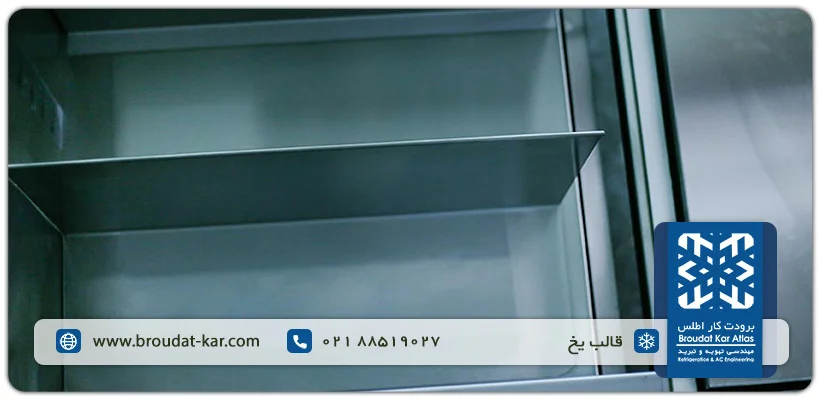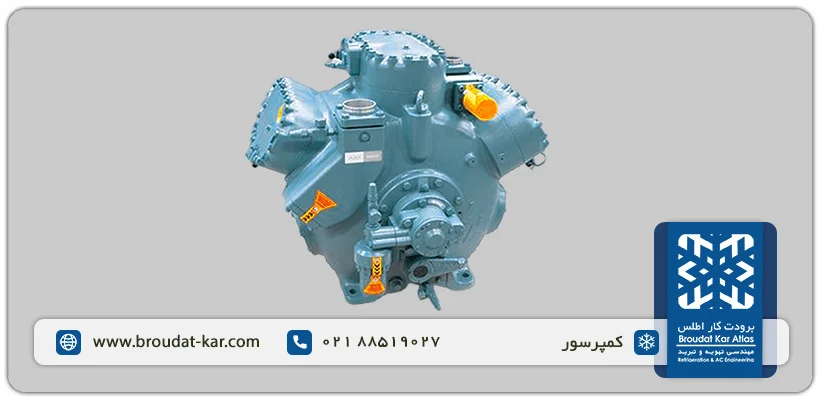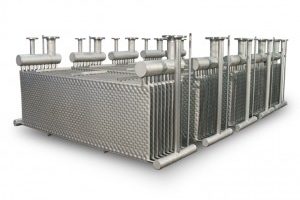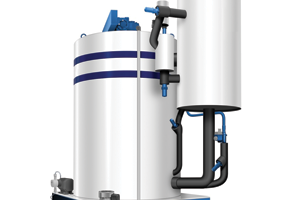What is a Block Ice Maker?
A Block Ice Maker, also referred to as a Block Ice Machine, is designed to produce block ice of diverse dimensions. The frequently used standard size typically comprises 25-kilogram blocks, measuring 15×15 centimeters with a height of 110 centimeters. This standard size finds widespread usage across various industries and applications in the food sector.
Industrial block ice makers boast a production capacity ranging from about 1 ton per day, equivalent to 40 blocks of 25 kilograms, to as high as 150 tons per day, which translates to 6000 blocks of 25 kilograms.
The block ice machine, invented in the 1840s by John Gorey, was initially intended for food cooling and preservation. Today, block ice finds utility across diverse industries.

Capacity, Number of Blocks per Hour, and Power Consumption
| Row | Daily Capacity (Tons) | Block Qty * Block Weight | Shifts per Day | Cooling Capacity (KW) | Power Consumption (KW) |
| 1 | 1 | 25 × 20 | 2 | 7/86 | 6 |
| 2 | 2 | 50 × 20 | 2 | 15/63 | 10 |
| 3 | 3 | 60 × 25 | 2 | 21/4 | 14 |
| 4 | 5 | 100 × 25 | 2 | 43/3 | 25 |
| 5 | 10 | 200 × 25 | 2 | 86/6 | 50 |
| 6 | 15 | 300 × 25 | 2 | 118/2 | 75 |
| 7 | 20 | 400 × 25 | 2 | 155/7 | 105 |
| 8 | 25 | 500 × 25 | 2 | 199/2 | 120 |
| 9 | 30 | 600 × 25 | 2 | 236/4 | 150 |
Operation of Block Ice Maker
The operation of a Block Ice Maker involves a systematic process. Initially, sanitary water-filled molds are placed within a tank containing brine, typically saltwater. The brine tank’s temperature is significantly lowered to approximately -10 to -15 degrees Celsius through a cooling system, while an agitator circulates the saltwater around the molds.
This controlled environment causes the water within the molds to solidify, transforming it into ice with a temperature ranging from -5 to -8 degrees Celsius. Once the water in the molds has fully converted into solid ice, an operator, using a crane integrated into the block ice maker, removes the molds from the brine tank. Subsequently, the ice is discharged from the molds.
The produced ice can then be used immediately according to consumption needs or packaged for later use, including storage within a cold storage facility. This process ensures the efficient production of block ice, ready for various applications based on demand.
Applications of Block Ice Maker
The applications of ice, especially through block ice maker factories, span across various industries and sectors. While encompassing all ice applications would be extensive, a glimpse at projects executed by Atlas Refrigeration Company indicates the primary utilization of block ice makers in the following sectors:
- Production and sale of sanitary ice
- Dairy industries
- Fisheries industries
- Chemical and paint industries
- Cooling concrete in civil and dam construction projects
- Food industries
- Transportation industries
- Ventilation and ice banks
Block ice finds crucial applications in various industries including sanitary block ice production, food, fisheries, chemicals, and construction. block ice widespread usage facilitates temperature control across diverse processes.
Components of Block Ice Maker
A Block Ice Maker comprises various essential components, each crucial for its efficient operation. Here’s an in-depth explanation of its main elements:
Ice Molds in the Block Ice Maker
Ice molds within a block ice maker can be tailored to suit specific requirements. While the standard molds weigh 25 kilograms, customized options ranging from 5 to 50 kilograms are available. Larger molds translate to longer ice-making cycles: 25-kilogram molds take about 8 hours, 50-kilogram molds extend to approximately 12 hours, while 10-kilogram molds shorten the cycle to around 5.5 hours. These molds can be crafted from galvanized or stainless steel (304 or 316), with sheet thickness varying from 1.25 to 2 millimeters.
Refrigeration Compressor in Block Ice Maker
The power of the compressor is determined based on the daily ice production capacity. The compressor’s selection involves assessing needs and aligning the budget with the machine’s cost. Options include reciprocating piston or screw-type compressors, available in freon or ammonia-based models. Several renowned compressor brands are prevalent in the market listed as below
- Bitzer – Germany
- Bock – Germany
- Grasso – Netherlands
- Kirloskar – India
- Gram – Denmark
- Sabroe – Denmark
- Dorin – Italy
- Refcomp – Italy
Evaporator in Block Ice Maker
The evaporator coil, situated within the brine tank, cools the saltwater and significantly impacts the ice-making cycle’s duration, efficiency, and the machine’s lifespan. The design aims for easy refrigerant circulation and reduced saltwater temperature. Evaporator, created by experienced technical teams, differ based on ammonia or freon-based systems.
Condenser in Block Ice Maker
The condenser, acting as a heat exchanger, dissipates heat from the molds and motor to the environment. It comes in various types like water-cooled, air-cooled, chosen based on regional temperature, humidity, water accessibility and refrigerant type.
Electrical Panel in Block Ice Maker
Compliant with global standards, the electrical panels are produced by Atlas Refrigeration Company, incorporating equipment from reputed Korean and European brands. Their protection level is IP54 or higher rating ensures protection. The control equipment enables semi-autonomous operation, requiring minimal operator intervention.
Block Ice Maker Tank
Made from alloyed steel sheets, the tank’s design considers mold water absorption and freezing capacity. For industrial-capacity models, on-site assembly and welding are necessary, a task handled by Atlas Refrigeration Company’s technical team.
Each component within a Block Ice Maker plays a critical role, collectively contributing to efficient ice production across various industrial applications.
Stages of Block Ice Production in a Block Ice Factory
The setup begins by installing all the mechanical and electrical components of the block ice maker. Then, a saltwater solution with a concentration of about 23% is prepared, adjusting its freezing point to approximately -21 degrees Celsius, where the brine tank temperature never intended to reach below -15 degrees Celsius. This solution could be prepared inside the tank or poured into the tank of the block ice maker after.
Once the saltwater solution reaches the desired temperature range, the block ice maker is activated to start the ice-making cycle. As the solution continues to cool, the ice molds, often arranged in bundles called “mold frames,” are filled with water. A crane assists in lifting these molds from their positions, guiding them to the filling station, filling them with water, and then returning them to their original places within the tank.
The ice production cycle runs for a specified duration, influenced by environmental conditions, water quality, and equipment efficiency. When the cycle completes, the ice is ready for discharge. The crane is used again to lift the molds, allowing the ice blocks to be removed and prepared for further processing or storage.
Once the ice is discharged, the molds are primed for the next water intake, marking the start of a new ice production cycle. This continuous process ensures a steady supply of block ice in the factory for various industrial applications.
Services of Atlas Refrigeration Company for Purchasing Block Ice Maker
Atlas Refrigeration Company is committed to providing tailored solutions for purchasing block ice makers, aligning with your specific needs and financial considerations. Boasting an illustrious 40-year legacy in Iran’s refrigeration sector and the successful execution of numerous end-to-end projects (EPC), the company offers comprehensive services. These services encompass design, manufacturing, installation, operational training, maintenance, and post-sales support for block ice makers to cater to the diverse requirements of valued customers.
Design of Block Ice Maker
Leveraging extensive expertise and a skilled technical team, Atlas Refrigeration Company custom designs block ice makers devices tailored to the unique specifications of each project. Our meticulous design process encompasses a range of critical factors: determining compressor capacity, ice block dimensions, weight, material and thickness, shift durations, electrical panel design, evaporator coil configuration, and the preparation of pertinent executive drawings and flow diagrams. Recognizing the distinct variations in water temperature, geographical considerations, and specific production requisites, our experts craft individualized industrial block ice makers for each project.
Manufacturing of Block Ice Maker
Atlas Refrigeration Company prioritizes top-tier manufacturing standards for block ice makers, leveraging extensive engineering expertise and a seasoned workforce. Our commitment to quality extends to the utilization of renowned control and electrical equipment sourced from esteemed brands like Danfoss, Siemens, among others, ensuring the longevity and superior quality of the manufactured ice makers.
Implementation of Block Ice Maker
The installation and commissioning of block ice makers demand a collective effort from specialists across multiple disciplines. Our team at Atlas Refrigeration Company brings together expertise in refrigeration, mechanical, electrical, and metallurgical fields, collaborating seamlessly with skilled welding, electrical, and technical technicians. With our experienced technical team traveling across various regions in middle eastern countries, we’ve successfully completed numerous projects in this field, ensuring impeccable execution.
Operation and Maintenance of Block Ice Maker
Maintaining the block ice maker in optimal condition requires diligent operation, proactive maintenance, and regular servicing to prolong its lifespan and ensure uninterrupted ice production. At Atlas Refrigeration Company, we provide comprehensive training in these areas and equip operators and technical staff with essential checklists to support these objectives.
After-Sales Services for Block Ice Maker
In our view, a sale marks the start of our commitment, not the conclusion of a transaction. At Atlas Refrigeration Company, we are dedicated to promptly resolving any potential issues with our block ice makers. We provide a one-year warranty and a decade of after-sales support for our block ice makers, aiming to guarantee the satisfaction of our esteemed customers.
Pricing of Block Ice Maker
Determining the cost of an industrial ice maker involves assessing unique project specifications for quality, stability, and operational efficiency. At Atlas Refrigeration Company, we offer free custom estimates tailored to your needs. To discuss pricing specifics or request a quote for a block ice maker, please reach out to our experts via the “Contact Us” page.
Summary of Block Ice Maker
Crafting block ice makers demands expertise across multiple fields, considering the distinctive demands of each project. Critical decisions like equipment selection, mold material, and auxiliary construction require the insights of a technical engineer. Atlas Refrigeration Company pledges steadfast support, delivering tailored engineering solutions, superior-quality block ice makers, and competitive pricing, ensuring customer satisfaction throughout the process.Top of Form
Related posts
Block Ice Maker
Flake Ice Machine The Flake Ice Machine, also known as a flake ice maker, is a device designed to generate










